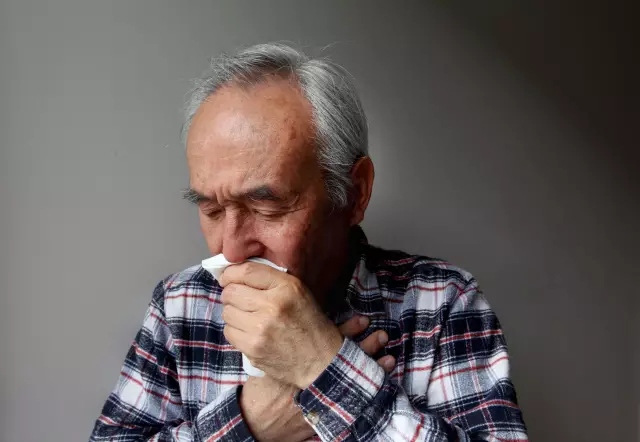- Author Rachel Wainwright [email protected].
- Public 2023-12-15 07:39.
- Last modified 2025-11-02 20:14.
Hyperventilation syndrome

Hyperventilation syndrome is an autonomic disorder, the main symptom of which is the patient's shortness of breath. This symptom of hyperventilation syndrome has nothing to do with problems of the lungs, bronchi or heart. The feeling of lack of air causes disturbances in the autonomic sphere of the nervous system. It controls the processes of human life that are not subject to his consciousness.
However, in addition to automatic control over their breathing, a person is also able to independently control the frequency of breaths or, if desired, do not breathe for a while. The combined respiratory control system is the basis for the development of hyperventilation syndrome. In a state of anxiety or stress, under the influence of fear or overwork, a person can unconsciously change the rhythm or depth of breathing, and then feel a lack of air in the lungs. As a result, he develops a panic attack, which further aggravates the course of the hyperventilation syndrome.
The cause of the hyperventilation syndrome can also be a person's suspiciousness, his susceptibility to other people's influence. People often feel an acute shortage of air when observing patients with asthma or shortness of breath. This event can take hold in the memory of a person and cause the development of hyperventilation syndrome many years later.
Hyperventilation syndrome is quite common. Short-term attacks of respiratory distress are observed in 10-15% of the world's inhabitants. It is also considered to be one of the most common manifestations of imbalance in the human autonomic nervous system.
Hyperventilation Syndrome Symptoms
Disruptions in the breathing program cause changes in the composition of the blood. This leads to a number of typical symptoms of hyperventilation syndrome. The patient feels "goosebumps" all over the body, cramps, muscle stiffness, pain in the heart, dizziness, etc.
A person with an attack of hyperventilation syndrome experiences panic and tries to control their breathing. Against the background of increased deep breaths, he has a feeling of squeezing in the chest, as well as a lump in his throat. Arrhythmia or tachycardia (uneven or rapid heartbeat) is often associated with pain in the heart. Therefore, patients often mistake the symptoms of hyperventilation syndrome for heart disease.
Patients with hyperventilation syndrome are often preoccupied with the problem of fresh air. They feel anxious in crowded places, often ventilate the room, and do not like confined spaces. These people are focused on their breathing behavior - this is how the neurological symptoms of hyperventilation syndrome appear.
A group of different gastrointestinal disorders is another symptom of hyperventilation syndrome. Patients with this disease usually have complaints of increased intestinal motility, aerophagia (swallowing air while eating), belching, and bloating. Such a wide range of symptoms of hyperventilation syndrome significantly complicates the diagnosis of the disease.
Diagnostics of the hyperventilation syndrome
The initial stage in the diagnosis of hyperventilation syndrome is based on the exclusion of a number of diseases accompanied by similar symptoms. Hyperventilation syndrome is similar in clinical symptoms to the pathology of the lungs, endocrine system, heart, and intestines.
The minimum plan for examining a patient with suspected hyperventilation syndrome includes consultations with a therapist, neuropathologist, cardiologist and endocrinologist. Instrumental methods for diagnosing hyperventilation syndrome include an ECG of the heart, an X-ray of the lungs, an ultrasound of the thyroid gland.
The Naymigen questionnaire is used as a rapid diagnostic method to assess the severity of symptoms of hyperventilation syndrome.
Treatment of hyperventilation syndrome

Treatment of hyperventilation syndrome is complex. First, the efforts of doctors are aimed at changing the patient's attitude to his disease. Hyperventilation syndrome is not a serious illness, it does not lead to death or disability. Awareness of this fact is one of the prerequisites for the successful treatment of hyperventilation syndrome.
To restore the normal breathing rhythm, the patient is advised to perform daily breathing exercises. For severe attacks of hyperventilation syndrome, a paper bag breathing technique is used. This method allows you to quickly increase the level of carbon dioxide in the blood and therefore is widely used in critical situations during a patient's panic.
To reduce the level of anxiety of the patient, it is also proposed to treat hyperventilation syndrome with medication, namely the use of antidepressants and anxiolytics. It is carried out under the supervision of a neuropathologist. The duration of drug treatment of hyperventilation syndrome is on average 4-6 months.
YouTube video related to the article:
The information is generalized and provided for informational purposes only. At the first sign of illness, see your doctor. Self-medication is hazardous to health!






